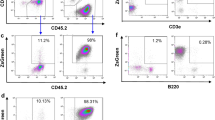Abstract
POLYOMA virus will induce neoplasms in most strains of newborn mice but not usually in mice older than 2 weeks1,2. Adult mice infected with polyoma virus are relatively more resistant to challenge of syngeneic polyoma-type tumours3. Such resistance can also be induced by homografts of polyoma tumours4. This resistance is not dependent on circulating viral antibodies and can apparently be transferred to normal recipients by lymphoid cells from immunized mice. To interpret these findings, Habel5 and Sjögren et al.6 proposed that polyoma virus transforms normal cells to neoplastic cells in the newborn and in the adult mouse, and that the transformed cells now contain a new foreign cell antigen which will provoke an immune response in the adult but not in the newborn animal. Thus, ordinarily, neoplasms will arise in newborn animals, whereas adult animals are capable of rejecting tumour cells containing foreign antigen. This tumour antigen is apparently common for most polyoma tumours induced by the same strain of virus7. This concept is supported by the finding that thymectomy during the immediate postnatal period—known to effect maturation of immunological faculty–can alter the course of polyoma virus oncogenesis. Thymectomy at 3 days of age rendered normally highly resistant (C57BL) mice susceptible to the oncogenic action of polyoma virus8. The same effect was found when the virus was injected into mice 1 month old9. Mice thymectomized when 3 days old and then infected with polyoma virus were unable to develop transplantation resistance against a challenge of syngeneic polyoma tumour cells10. Additional evidence is now reported that C57BL mice, thymectomized at 3 days of age and then immunized with homografts of polyoma tumour cells when 1 month old, are unable to develop resistance against challenge by syngeneic polyoma tumour cells.
This is a preview of subscription content, access via your institution
Access options
Subscribe to this journal
Receive 51 print issues and online access
$199.00 per year
only $3.90 per issue
Buy this article
- Purchase on Springer Link
- Instant access to full article PDF
Prices may be subject to local taxes which are calculated during checkout
Similar content being viewed by others
References
Dawe, C. J., Law, L. W., and Dunn, T. B., J. Nat. Cancer Inst., 23, 71 (1959).
Dawe, C. J., J. Nat. Cancer Inst. Monograph, 4, 67 (1960).
Habel, K., Proc. Soc. Exp. Biol. and Med., 106, 722 (1961). Sjögren, H. O., Virology, 15, 214 (1961).
Sjögren, H. O., J. Nat. Cancer Inst., 32, 645 (1964).
Habel, K., J. Exp. Med., 115, 181 (1962).
Sjögren, H. O., Hellstrom, I., and Klein, G., Exp. Cell Res., 23, 204 (1961).
Sjögren, H. O., J. Nat. Cancer Inst., 32, 361 (1964).
Miller, J. F. A. P., Ting, R. C., and Law, L. W., Proc. Soc. Exp. Biol. and Med., 116, 323 (1964).
Law, L. W., and Ting, R. C., Proc. Soc. Exp. Biol. and Med., 119, 823 (1965).
Ting, R. C., and Law, L. W., J. Nat. Cancer Inst., 34, 521 (1965).
Moeller, G., J. Immunol., 86, 56 (1961).
Glynn, J. P. (personal communication). Ting, R. C. (unpublished data).
Leckband, E. (personal communication).
Author information
Authors and Affiliations
Rights and permissions
About this article
Cite this article
TING, R. Effect of Thymectomy on Transplantation Resistance induced by Polyoma Tumour Homografts. Nature 211, 1000–1001 (1966). https://doi.org/10.1038/2111000a0
Issue Date:
DOI: https://doi.org/10.1038/2111000a0
This article is cited by
Comments
By submitting a comment you agree to abide by our Terms and Community Guidelines. If you find something abusive or that does not comply with our terms or guidelines please flag it as inappropriate.



